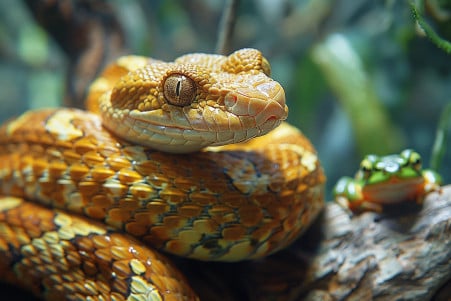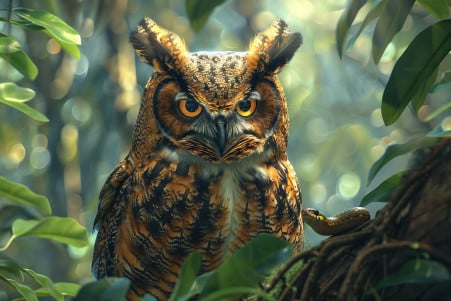What Do Snakes Eat? A Look at Snakes That Eat Grasshoppers
3 May 2024 • Updated 2 May 2024

In the wild and in captivity, many snakes eat grasshoppers and other insects. Snakes are meat-eating reptiles, but because they don’t have venom and can’t chew their food, they have to eat small prey like grasshoppers whole. Grasshoppers provide the protein and nutrients that snakes need to live and grow, but larger snakes tend to prefer rodents and frogs.
This article will look at research by herpetologists and animal behaviorists to find out more about the eating patterns and prey choices of different snakes in different environments. This will help us learn more about snakes’ natural behaviors and needs, including how they find, catch, and eat grasshoppers, and the role that eating insects plays in their lives. You’ll come away with a better understanding of how well snakes are adapted to being insect-eating hunters.
Do snakes eat grasshoppers?
Hunting Tactics: How Snakes Catch Grasshoppers
Snakes have evolved an array of specialized senses and hunting strategies to effectively locate and capture agile grasshopper prey. As noted by Pets on Mom.com, snakes can detect vibrations through their jawbones, which helps them "hear" the movements of insects close by. Meanwhile, certain pit viper species use heat-sensing pits on their heads to detect the thermal signatures of grasshoppers. Snakes also use their forked tongues to detect the scent of potential prey.
Ambush predators like vipers use their thick bodies and venom delivery systems to deliver powerful strikes that quickly disable grasshoppers. On the other hand, active hunters like rat snakes use speed and agility to chase after their prey. Some constrictors wrap their bodies around grasshoppers to immobilize them before eating them.
Even water snake species have developed special ways to eat when they're hunting larger prey. The Gerarda snake tears large crabs apart, while the Fordonia snake uses its chin to pin its prey in place before wrapping its body around it. These different hunting strategies show how different snake bodies have evolved to capture grasshopper prey in a variety of environments.
Nutritional Content: What Grasshoppers Bring to the Table
Grasshoppers are a rich source of nutrition for snakes. According to Do Snakes Eat Grasshoppers?, grasshoppers are packed with proteins, vitamins, minerals, and amino acids that are essential for snakes to grow and thrive. In addition, the exoskeleton of grasshoppers can help snakes with digestion and shedding.
The Merck Veterinary Manual suggests that snakes in captivity should be given a variety of prey to ensure that they get all of the nutrients that they need. While live prey may be more stimulating for some snakes, pre-killed insects from reputable sources are recommended to minimize the risk of spreading disease. This is important for ensuring that snakes get the nutrition that they need to thrive.
The fact that grasshoppers are so common and so nutritious makes them an important food source for snakes in the wild and in captivity. Knowing what grasshoppers bring to the table in terms of nutrition can help us understand how important they are for keeping snake populations healthy.
Environmental Impacts: Snakes and the Control of Grasshopper Populations
Snakes are important predators that help to keep pest populations, such as grasshoppers, in check. The Wildlife Epidemiology Laboratory explains that the loss of snakes would have "extreme consequences" for many "pest" animals that would see their populations explode without their natural predators. Snakes are considered "mesopredators" in the food web, as they eat smaller animals and are also eaten by larger predators.
Changes in grasshopper populations can have a big impact on snakes and the rest of the animals in these complex food webs. The George Institute for Global Health explains that the loss of snakes due to habitat destruction has led to "outbreaks" of rodents and other prey species. Meanwhile, the Xerces Society points out that the use of insecticides to control grasshoppers can also hurt the snakes that would naturally control their populations, potentially making outbreaks worse.
Conserving habitats that support natural predators like snakes could help to control grasshopper populations in a more sustainable way. As In Defense of Snakes and Their Importance to Ecology explains, snakes are important "ecosystem service providers" that help to maintain biodiversity. Conserving snake habitats is important to maintaining the delicate balance between predators and prey.
Venomous vs. Non-Venomous: Hunting Techniques
Venomous and non-venomous snakes use different techniques to hunt grasshoppers. As explained in Defensive Venoms: Is Pain Sufficient for Predator Deterrence?, venomous snakes can quickly paralyze grasshoppers with their venomous bites. Non-venomous constrictors, on the other hand, use their bodies to coil around the grasshoppers and subdue them.
That said, the evolution of resistance in certain prey species, such as the southern grasshopper mouse, has made it harder for venomous snakes to hunt. This is discussed in The Diversity of Venom, which explains that venomous snakes may be able to change the composition of their venom to better hunt different types of prey.
In the end, venom or no venom dictates how snakes hunt, but as The Animals That Venom Can't Touch explains, both venomous and non-venomous snakes are able to hunt grasshoppers. Their adaptations have made them successful insectivores in a wide range of environments.
Climate Change Impacts: Threats to Grasshopper Populations
One study from the University of Missouri suggests that climate change is contributing to the increase in snake populations and their predation on grasshoppers. The warming climate has caused even the interior of forests to become warmer, which has increased snake activity and the demand for food. This has caused a decline in the populations of young birds, which are a primary food source for snakes.
In addition, habitat loss and degradation can lead to a decrease in grasshopper populations, which would in turn limit the food supply for snakes. Drought and lower precipitation levels also reduce grasshopper reproduction and abundance. As a result, the warming climate is expected to make the habitats of some snakes uninhabitable, which would further threaten snake species.
It is important to maintain the right grassland ecosystems to ensure that the grasshopper-snake food web can continue to exist. Conservation efforts that focus on protecting the habitats of snakes and the populations of grasshoppers will be necessary to ensure that these important predator-prey relationships can continue in the face of climate change.
Conclusion: Why We Should Appreciate the Reptilian Insectivores
Snakes are important regulators of insect populations like grasshoppers through predation. Their wide range of hunting methods and specializations enable them to successfully catch these fast-moving prey. Grasshoppers are a rich and plentiful food source that enables snakes to grow and stay healthy.
Yet, this predator-prey relationship is under threat from environmental factors such as climate change and habitat destruction. The George Institute for Global Health points out that the loss of snake populations, often due to habitat destruction, can result in "outbreaks" of rodents and other prey species. Meanwhile, the Xerces Society observes that the use of insecticides to control grasshopper populations can have a negative impact on the snakes that naturally prey on them, potentially making outbreaks worse.
This is why it's so important to protect snake habitats and encourage sustainable grassland management. As In Defense of Snakes and Their Importance to Ecology explains, snakes provide important "ecosystem services" that help maintain biodiversity. Protecting snake habitats is essential to maintaining this delicate predator-prey relationship.


